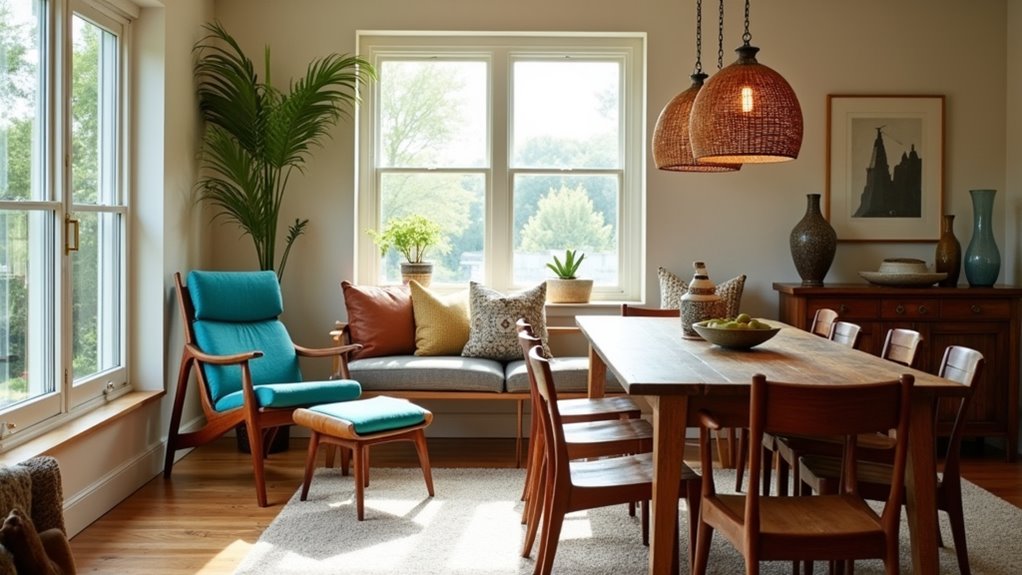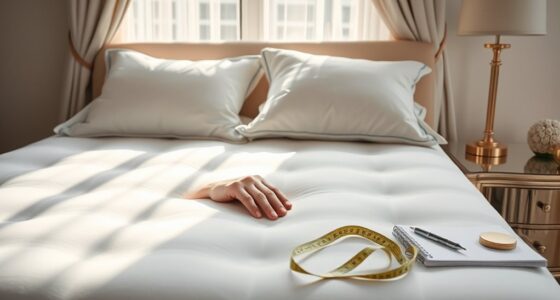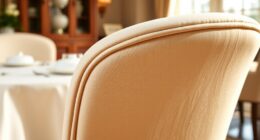Understanding different furniture styles can transform your space into a true reflection of your personality. Mid-Century Modern boasts clean lines and vibrant colors, while Modern Farmhouse blends rustic warmth with contemporary flair. Bohemian style offers an eclectic vibe filled with vibrant hues, and Scandinavian design emphasizes simplicity and functionality. Industrial style brings a raw, minimalist aesthetic, whereas blending elements harmonize traditional and modern influences. Explore these styles to find what resonates with you, and discover more insights.
Key Takeaways
- Furniture styles reflect cultural trends and personal preferences, ranging from traditional elegance to modern minimalism.
- Mid-Century Modern is characterized by clean lines, vibrant colors, and natural materials, offering timeless appeal.
- Modern Farmhouse combines rustic charm with contemporary design, emphasizing comfort, functionality, and a neutral color palette.
- Scandinavian design focuses on simplicity and minimalism, using natural materials and promoting natural light in interiors.
- Industrial style showcases a raw aesthetic with exposed structural elements, salvaged materials, and a neutral color scheme for a bold look.
Overview of Furniture Styles
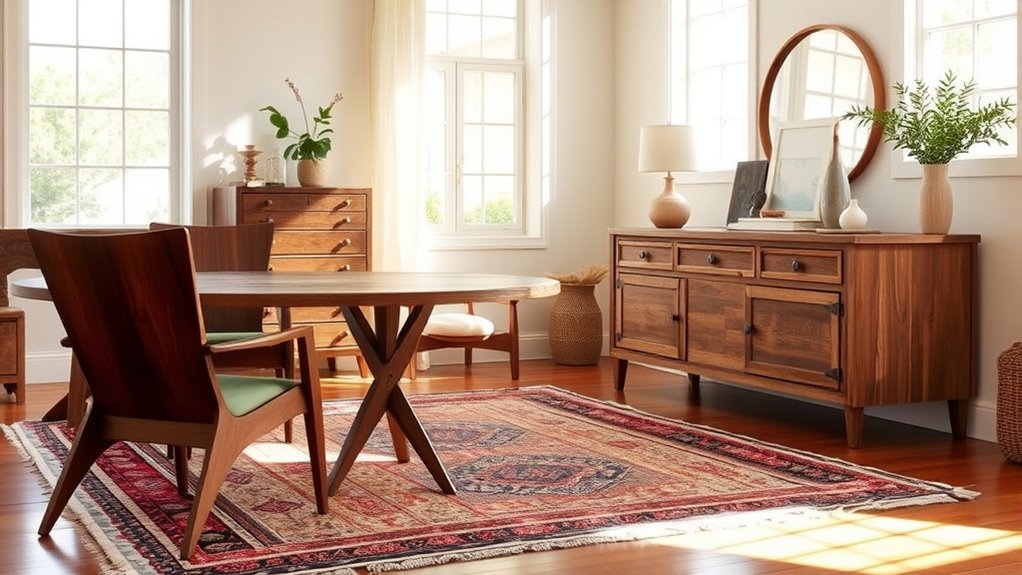
Furniture styles are like a window into history, reflecting cultural shifts and personal tastes.
From Traditional designs that embrace classic elegance and warm tones to the sleek, clean lines of Mid-Century Modern, each style has unique characteristics.
Modern Farmhouse blends rustic charm with contemporary flair, often using a neutral palette and vintage accents to create inviting spaces. Incorporating natural materials into farmhouse design enhances its authenticity and warmth, with best woods for farmhouse tables providing durability and character. This style is particularly noted for its use of shiplap walls, which adds a distinctive touch of rustic appeal.
Scandinavian design focuses on simplicity and functionality, incorporating natural materials to foster warmth and comfort.
On the other hand, Industrial furniture captures the raw, urban essence of repurposed factories, highlighting exposed structures and a mix of metal and wood.
Understanding these furniture styles helps you appreciate the interplay between design, culture, and the environment.
Mid-Century Modern

Mid-Century Modern design, which emerged in the wake of World War II, captures the essence of innovation and style from the 1940s to the 1970s.
This aesthetic is characterized by a blend of vibrant colors and natural materials, offering both beauty and functionality.
- Clean lines and minimal ornamentation
- Iconic design elements like pointed wooden legs
- A focus on functional forms and comfort
- Influences from Scandinavian design and a minimalist approach
- Timeless appeal for contemporary interiors
With its seamless integration of indoor and outdoor living, Mid-Century Modern furniture remains a popular choice today. Its ability to adapt to various settings showcases its enduring charm and versatility, making it a staple in modern homes. Additionally, the combination of natural materials is a key aspect of achieving a cohesive look that resonates with various design styles. To create a truly inviting space, consider incorporating lighting design to enhance the ambiance and highlight the furniture’s unique features. The use of unique textures in textiles and accessories can further elevate the overall aesthetic of your Mid-Century Modern space. Furthermore, integrating elements like farmhouse textiles can create a warm and inviting atmosphere that complements the clean lines of Mid-Century Modern design.
Modern Farmhouse
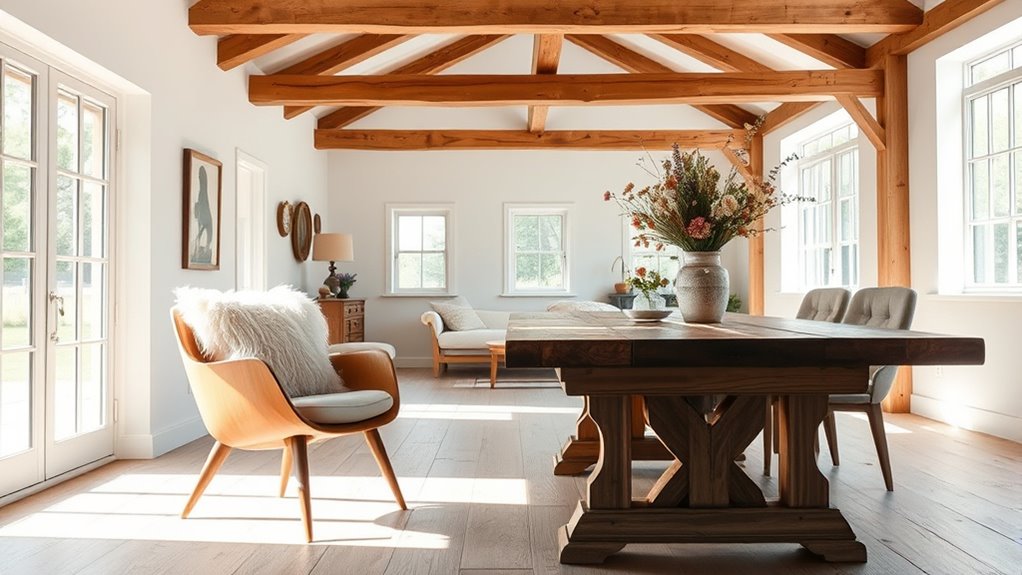
Modern Farmhouse style blends rustic charm with contemporary touches, creating a cozy and functional space you’ll love.
With a focus on a neutral color palette and a mix of materials, this style emphasizes warmth and welcoming vibes. Incorporating natural materials such as wood and stone is essential for achieving the inviting atmosphere characteristic of modern farmhouse design. Additionally, the use of textured fabrics can further enhance the comfort and warmth of your living spaces. To add a touch of character, consider integrating whimsical wall decals that can bring a playful element to the overall aesthetic. Regular maintenance, including routine cleaning, can help preserve the beauty of your furniture and decor.
Let’s explore the key characteristics, color choices, and furniture materials that define this popular design.
Key Characteristics Defined
The charm of Modern Farmhouse style lies in its seamless blend of rustic warmth and contemporary design.
You’ll find that this style focuses on comfort and functionality while embracing a neutral color palette. Additionally, this design ethos prioritizes innovative interior design that creates inviting, livable spaces for all. The incorporation of natural materials is essential to achieving a harmonious atmosphere. To enhance the overall aesthetic, integrating smart home technology can elevate both comfort and convenience.
Key characteristics include:
- Exposed wood beams and shiplap walls, enhancing rustic charm
- Mid-century modern furniture, adding a touch of modernity
- Use of natural materials like wood, metal, and stone for an organic aesthetic
- Curated decor pieces that reflect a mix of traditional and contemporary influences
- House plants that bring life to your space
Creating a cozy space that accommodates both families and seniors is an essential aspect of Modern Farmhouse design.
Color Palette Choices
While exploring the color palette choices in modern farmhouse style, you’ll discover a harmonious blend of neutral tones that create a serene atmosphere. The modern farmhouse palette typically features whites, soft grays, and beige, perfect for fostering warmth and simplicity. Accents of muted pastels and earthy shades, like sage green or dusty blue, add subtle color without overwhelming the space. Darker shades like charcoal or navy provide contrast and depth, especially in furniture or decor. Natural wood tones enhance the rustic charm and complement the overall design. Additionally, the incorporation of earthy shades can evoke a connection to nature, similar to themes found in folklore. By integrating beautiful, functional environments, you can elevate the comfort and aesthetic appeal of your home. The use of sustainable fashion principles in furniture design can further enhance the eco-friendly aspect of your modern farmhouse. The inclusion of high-quality equipment in your design process can ensure that your chosen furnishings are both beautiful and enduring, contributing to the longevity of your space.
| Color Type | Examples |
|---|---|
| Neutral Tones | Whites, Soft Grays |
| Earthy Shades | Sage Green, Dusty Blue |
| Dark Accents | Charcoal, Navy |
| Muted Pastels | Blush Pink, Pale Yellow |
Furniture Material Preferences
When creating a modern farmhouse space, the materials you choose for furniture play a pivotal role in achieving that welcoming atmosphere.
Focus on blending natural materials like reclaimed wood with metal to emphasize durability while maintaining a rustic charm. Additionally, incorporating non-combustible materials can ensure a safe environment when using wood stoves in your living space. It’s also important to consider local building codes to ensure your design meets safety standards.
Consider these essential furniture features:
- Soft neutral colors like whites and grays
- Comfortable fabrics like cotton and linen
- Vintage pieces that add character
- Large dining tables for gatherings
- Functional storage solutions for practicality
This combination not only enhances comfort but also fosters an inviting feel. Additionally, incorporating sustainable building materials can further enhance the eco-friendly appeal of your modern farmhouse design.
Bohemian Style
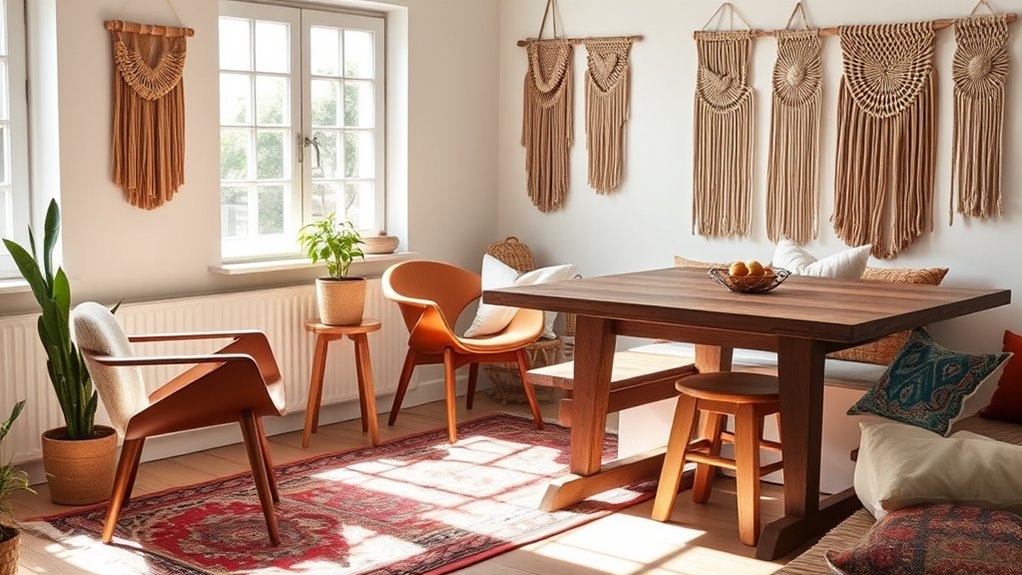
Bohemian style brings a relaxed, eclectic vibe to your space, blending colors, patterns, and textures that reflect your individuality.
You can incorporate layered textiles and unique vintage finds to create a cozy atmosphere that tells your story.
With a rich color palette and carefully curated accessories, you’ll achieve a vibrant look that feels both inviting and personal.
Key Characteristics of Bohemian
Embracing a vibrant and eclectic spirit, Bohemian style, often called “boho,” invites you into a world rich with colors, patterns, and textures.
This style creates an artistic atmosphere that reflects your individuality and creativity through a layered look.
- An eclectic mix of vibrant colors, including jewel tones and earthy hues
- Use of natural materials like wood and rattan
- Incorporation of vintage finds and handmade items
- A cozy space filled with plants and greenery
- An abundance of decorative elements like throw pillows and rugs
In Bohemian interiors, the emphasis on personal experiences and cultural influences results in a unique, maximalist approach that celebrates comfort and expression.
Incorporating Boho in Spaces
Creating a boho-inspired space allows you to showcase your personality while enjoying a cozy and inviting atmosphere. Embrace your unique style by incorporating bright colors and layered textiles, such as vibrant rugs, throws, and cushions.
Natural elements like wood, rattan, and lush plants enhance the organic feel of your environment, making it feel invigorating and alive. Look for vintage finds and handcrafted items that reflect your personal journey, creating a space that tells your story.
This eclectic mix prioritizes comfort and individuality, allowing you to relax and ignite your creativity. Remember, your bohemian space should be a true reflection of who you are, blending different influences to create a cozy haven that feels distinctly yours.
Scandinavian Design

When you think of Scandinavian design, you might picture spaces that are effortlessly stylish yet remarkably functional. This design style, rooted in Nordic countries, showcases clean and uncluttered spaces.
- Natural materials like light-colored wood
- Neutral color palette with whites and soft pastels
- Functional form and sleek lines in furniture
- Comfort combined with minimalism
- Textiles for warmth and texture
Emphasizing natural light, Scandinavian interiors often feature large windows that create bright, airy atmospheres.
The focus on functionality guarantees that every piece serves a purpose, making your home both inviting and practical.
Industrial Style

Industrial style captures the essence of urban living, drawing inspiration from repurposed warehouses and factories. This design emphasizes a raw aesthetic, showcasing structural elements like exposed pipes and beams. You’ll find a mix of salvaged materials, metals, and concrete, all contributing to a bold, minimalist look with a neutral color palette.
Here’s a quick overview of the key characteristics:
| Feature | Description |
|---|---|
| Open Spaces | Creates a sense of freedom and flow |
| Large Windows | Allows natural light to enhance the atmosphere |
| Vintage Furnishings | Blends old and new for visual contrast |
Incorporating distressed leather and factory-inspired accessories, this style promotes sustainable design while providing a rugged yet refined feel.
Transitional Elements
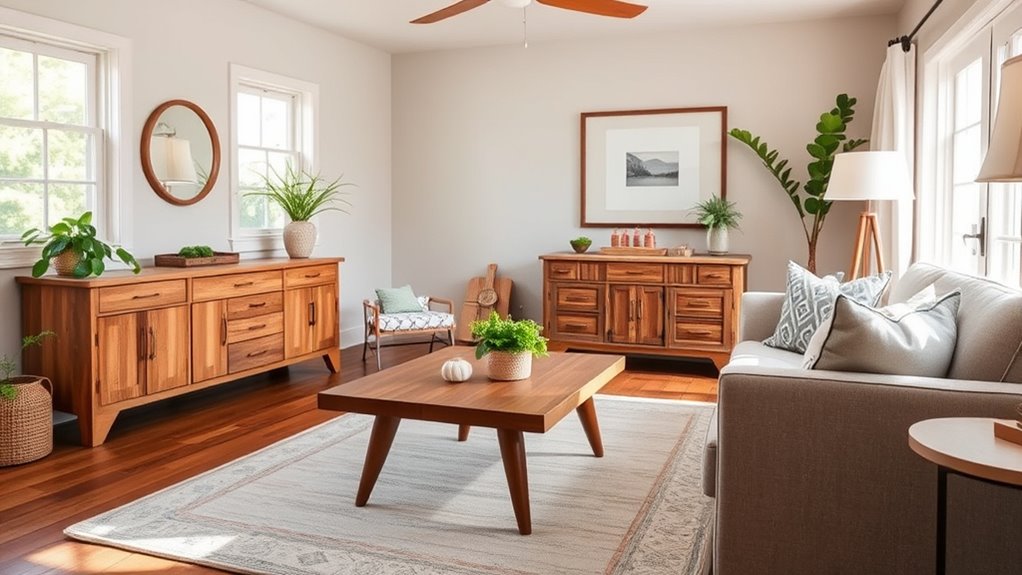
While industrial style showcases raw elements and urban flair, shifting elements offer a harmonious blend of traditional and contemporary design. The shifting style is perfect for those who appreciate a balanced aesthetic, combining elegance with comfort.
You’ll love the flexibility in decor, as the neutral color palette allows for pops of color that keep the space cohesive.
- Curved and straight lines foster a welcoming atmosphere
- Statement lighting adds character without overwhelming
- Rich textiles enhance visual interest
- It serves as a softer alternative to more embellished styles
- Perfect for versatile settings, from family homes to chic apartments
Embrace the shifting style, and enjoy a space that feels both timeless and modern!
Frequently Asked Questions
What Is the Difference Between Mid-Century Furniture and Mid-Century Modern Furniture?
When you look at mid-century furniture, you’ll find pieces from the 1940s to 1960s that mix modern and traditional styles.
In contrast, mid-century modern furniture specifically focuses on minimalist designs with clean lines and practical forms. It emphasizes organic shapes and natural materials, reflecting a streamlined aesthetic.
What Are 5 Key Elements of MCM Decor?
They say, “Less is more,” and that perfectly captures Mid-Century Modern decor.
You’ll notice five key elements: clean lines that evoke simplicity, organic shapes for a natural feel, vibrant colors that energize the space, natural materials like walnut and teak for warmth, and a focus on open spaces that invite light.
Embrace these elements, and you’ll create a harmonious environment that balances functionality with aesthetic appeal.
What Is the 1950S Furniture Style Called?
The 1950s furniture style is called Mid-Century Modern.
You’ll notice its clean lines and functional design elements that reflect the optimism of the post-war era.
This style often incorporates materials like wood and metal, along with vibrant colors in textiles.
If you appreciate minimalist aesthetics and organic forms, you’ll find Mid-Century Modern appealing.
It encourages a seamless blend with nature, making your space feel both stylish and inviting.
What Comes After Mid-Century Modern?
After Mid-Century Modern, you’ll notice design trends shift towards Minimalism in the late 20th century.
It emphasizes simplicity, focusing on “less is more.”
Then, in the 1980s, Postmodernism emerges, mixing bold colors and playful elements.
The early 2000s introduce Contemporary styles, highlighting clean lines and open spaces.
Conclusion
To sum up, exploring different furniture styles can transform your living space into a reflection of your personality. Did you know that nearly 60% of homeowners feel more relaxed in a well-designed environment? By mixing elements from Mid-Century Modern, Modern Farmhouse, and other styles, you can create a unique vibe that resonates with you. So, go ahead and experiment with these styles to make your home a true haven—your ideal space is just a few choices away!
